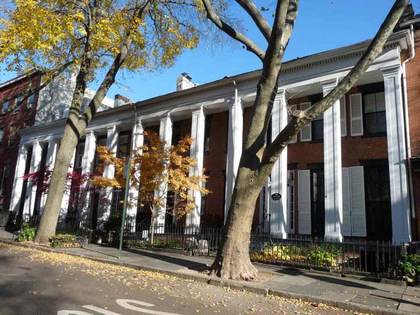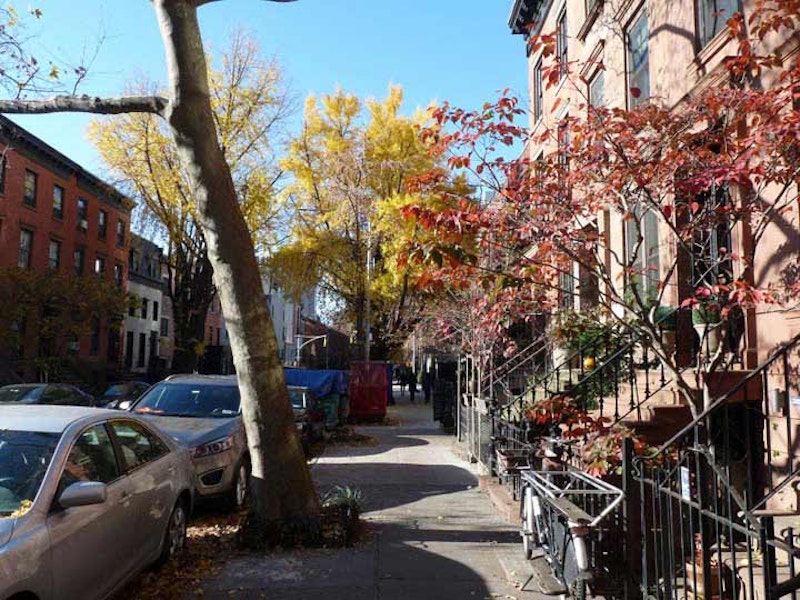I was in the mood for a compact voyage of discovery on a crisp fall day and recognized I hadn’t yet walked the entire length of State St. in Brooklyn Heights. It runs several blocks from Columbia Pl. east to Flatbush Ave. (I walked it from east to west, as the subway dropped me off at the east end.) Though much of it is classic Brooklyn architecture from the 1850s onward, there are some wild cards dropped in. In their Brooklyn By Name, Leonard Benardo and Jennifer Weiss omit State St., but in Clay Lancaster’s Old Brooklyn Heights, he says it may have been named for Manhattan’s State St., which curls along Battery Park from Bowling Green to South Ferry.

I wanted to check on one of my favorite mosaic signs in the city, made even more interesting because the church it demarcates was torn down several years ago. I exited at the Atlantic-Barclays station, formerly called Pacific St., at the NW corner of Pacific St. and 4th Ave. It’s a fantastic sign with bits of multi-colored mosaic tiles and two stained-glass windows. There’s another BMT “church mosaic” at the Court St. subway entrance at Montague St.

The Church of the Redeemer was razed in late-2015 to early-2016. It didn’t have protection by the Landmarks Preservation Commission, even though the Gothic-style Church of the Redeemer was built in 1866 and was designed by pre-eminent ecclesiastic architect Patrick Keely, who generally worked on Catholic church commissions. Maintenance had been deferred over the years and the church, which served a West Indian and Caribbean congregation, had incurred $4 million worth of repairs—prompting the Long Island Episcopal Diocese to close it. The church has been replaced by an irregularly-shaped luxury condo building called 561 Pacific.

Now heading west on State St., you encounter the YWCA at 3rd Ave. between Atlantic Ave. and Smith St. The YWCA was founded in 1888 and this seven-story branch was built here in 1927. It’s now a residential building providing housing and community programs. Alvin Ailey dancers, electrical engineers, former prisoners, retired teachers and an actress on The Wire all resided there at one time or another. About a dozen of the current residents have been here since the 1950s or 60s.

The former PS 15 at the opposite corner is likely the oldest building on 3rd Ave. (and State St.), built in 1840. It was given a red paint job a couple of decades ago that has long since faded to pink. In 1974 I got working papers here so I could work while still under 18. I remember getting a physical exam by a bored doctor in a dark room.
Today the building hosts a branch of the occasionally controversial Khalil Gibran International Academy, as well as the Metropolitan Corporate Academy High School. There’s a chiseled sign on the building identifying 3rd Ave. as Powers St. Before about 1870, 3rd Ave. from Flatbush Ave. to about Carroll St. was called Powers St., and was likely changed to 3rd Ave. because there was another Powers St. in East Williamsburg (Brooklyn annexed the city of Williamsburg in 1855). This is the only remnant of 3rd Ave.’s Powers St. days.

FDNY Engine 226 is at 409 State St. just west of Nevins. I like taking pictures of firehouses—the more red paint the better. This is one of the former firehouses of the old Brooklyn Fire Department that came into the FDNY after Brooklyn joined Greater New York in 1898. Horse-drawn fire wagons were once stationed here. The compact Queen Anne-style firehouse was built in 1889. Engine 226 lost four men on 9/11.

371 & 375 State St. are a massive pair of brick Queen Anne apartment buildings built between 1900 and 1905. The two arched entrances carry the names “Albemarle” and “Devonshire.” Around this time, applying British-sounding names to buildings, as well as streets, was very popular. When Prospect Park South and adjoining neighborhoods were developed, names such as Albemarle, Beverly, etc. supplanted the more prosaic Ave. A, B and so on.
At this point, State St. edges into Boerum Hill. As with so many other somewhat foreign-sounding names in NYC, it commemorates a Dutch colonial family: Willem Jacobse Van Boerum immigrated to New Amsterdam in 1649, and his great grandson Simon Boerum owned a large amount of land south of what’s now downtown Brooklyn in the years prior to the Revolutionary War. Boerum Place and the community of Boerum Hill (the hill was leveled long ago) commemorates him, and there’s a Boerum St. in East Williamsburg. Boerum Hill is one of a few distinct neighborhoods in a tightly-packed region that also includes the communities of Gowanus and Cobble Hill.

In previous forays in Boerum Hill, I stopped in what was one of the smallest diners I’d ever been in, Victory Cafe at the SE corner of Hoyt and State. That restaurant closed in 2011 and the space is now occupied by Grand Army, named for the plaza at the north end of Prospect Park, about two miles south. Grand Army, according to its website, “[specializes] in craft cocktails, sustainable seafood and seasonal vegetable dishes.” The kind of place that serves sea urchin. I’ve never sampled such spiny fare.

The Brooklyn Detention Complex at Atlantic Ave. and Boerum Pl. was constructed in 1957, replacing Miller’s Furniture Store. It closed in 2003 but reopened in 2012, much to the consternation of locals; it closed again in early-2020. The city keeps threatening to close the Rikers Island jail complex and open a number of detention centers throughout the city, also to much consternation. This isn’t a prison, but a place where accused people who can’t afford bail await trial. There are a number of bail bonds places in the immediate vicinity.

Here on the first floor at #169 Clinton St., corner of State, for most of 1925 lived H.P. Lovecraft (1890-1937). Closely associated with Providence, RI, his home for most of his life, Lovecraft moved to a one-floor apartment here in what was then a depressed part of Brooklyn after his wife, Sonia, moved to Cincinnati, OH to find work in a department store. Lovecraft was unhappy in Brooklyn, and moved back to Providence in 1926 as his marriage foundered. Most of his suits were robbed during his stay, the only thing he had in the apartment beside his books worth stealing. His stories “He” and “The Horror At Red Hook,” neither of which present NYC in a favorable light, were written during this period.

This group of brick buildings at #43-49 Willow Pl., just off State, is my favorite grouping in Brooklyn Heights. United by a common columned front porch, they’ve been called Brooklyn’s last colonnade row. All were built by 1847. This unit is meticulously cared for by their owners, with the wood posts receiving frequent paint jobs in gleaming white.

The Adam Yauch Playground at the west end of State St. at Columbia Pl. Since its inception in 1944 when the BQE was under construction, the park space has had a number of names: Atlantic Playground; State Street Park (1950s); Palmetto Playground (1987) and finally, renamed for Brooklynite Beastie Boy Adam Yauch (1964-2012) who founded the group in 1981, toured the world, and sold millions of records. A convert to Buddhism, Yauch raised millions via the Tibetan Freedom Concerts. Yauch conceived and produced most of the Beastie Boys’ innovative and hilarious videos.
—Kevin Walsh is the webmaster of the award-winning website Forgotten NY, and the author of the books Forgotten New York (HarperCollins, 2006) and also, with the Greater Astoria Historical Society, Forgotten Queens (Arcadia, 2013)

